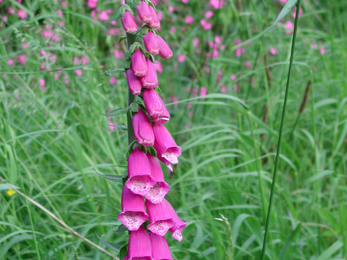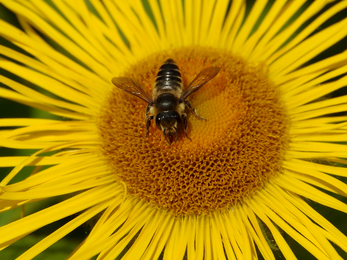The Get Dorset Buzzing campaign is all about helping pollinators throughout the seasons. You might think summer is an easy time for pollinators, but it can actually be difficult because wildflowers in the wider countryside stop flowering and go to seed in July, so bees, butterflies, moths and hoverflies become more reliant on our gardens for pollen and nectar. Non-native plants such as Verbena bonariensis, buddleia, echinacea, ice plant and rudbeckia help extend the season into autumn, and pollinators flock to them for sustenance.
What’s more, some pollinators, such as some species of bumblebee and solitary bee, have already finished their lifecycles for the season. Daughter bumblebee queens will be mating and feeding up on nectar ahead of hibernation, while solitary bees such as red mason bees and tawny mining bees have long since died – only their grubs survive now, which are eating the stores of pollen and nectar left for them by their mothers. They won’t emerge until next spring. However, late summer is leafcutter bee season. If you have a bee hotel then look out for bees carrying sections of leaf into it to seal their nests, while elliptical ‘holes’ in the leaves of roses and wisteria will let you know they’re making good use of your plants. From September, the ivy bees emerge. Look out for them nesting in lawns and borders. They feed almost exclusively on ivy nectar and pollen – which is a fantastic resource for a range of late-flying pollinators.
Keep an eye out for butterflies in the garden, too. From late July to October, the second generation of Nymphalids – the small tortoiseshell, peacock, comma, painted lady and red admiral butterflies – is on the wing. It was back in spring when their ‘grandparents’ emerged from hibernation or arrived from Continental Europe. They will have fed up on nectar after their long sleep or journey, and laid eggs on nettles, before dying. Their offspring, the first, ‘spring’ generation of adults, will have emerged from the nettles a few weeks later, and they too will have mated and laid eggs, but in greater numbers. Now this second generation is ready to fly, and will be hungry for nectar so they can feed themselves up before going into hibernation or returning to the Continent. Last year’s hot, sunny weather saw a spike in the populations of many of these species, so as long as we have some good sunny days and a bit of rain over the coming weeks, we can expect to see some of these colourful butterflies on our buddleias.
What to do now
It’s not too late to buy plants – you can buy plants in flower from the garden centre from July through to autumn, and use bedding plants such as cosmos to fill gaps in the border. Deadhead (remove) spent flowers to keep the plants producing more blooms, and keep them well-watered so there’s always plenty of nectar to go around. This is especially true for perennial wallflowers such as ‘Bowles’s Mauve’, which could flower for every month of the year if you keep cutting back old blooms and watering well.
Late summer is the perfect time to sow biennials. These are plants which develop a deep taproot in their first year and then flower, set seed and die the second. Many of them are great for pollinators. They include plants such as foxgloves, honesty and sweet rocket. Prepare a seed tray with peat-free, multipurpose compost and water it well, allowing the water to drain. Scatter seeds sparingly over the surface and cover with a thin layer of compost or vermiculite. Keep moist. The seeds should germinate within a couple of weeks. Transplant them into individual pots when they’re large enough to handle and then plant them out next spring. If you’re lucky they will flower next summer.
Heading into autumn, it’s time to start thinking about your autumn bulb orders for next year. Crocus, grape hyacinths, snake’s head fritillaries and alliums are the best bulbs for bees. You can grow these in pots on the patio or balcony, or plant them in the border. Crocuses and snake’s head fritillaries work well when planted in the lawn. Think of it as burying treasure that will feed the first bees of next year, some of which are taking the last dregs of nectar from your late-summer flowers, now.
For more on the Get Dorset Buzzing campaign, to sign up and to watch videos, click here.



